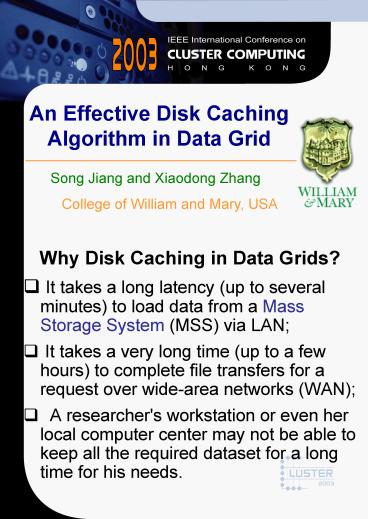An Effective Disk Caching Algorithm in Data Grid - PowerPoint PPT Presentation
1 / 8
Title:
An Effective Disk Caching Algorithm in Data Grid
Description:
It takes a long latency (up to several minutes) to load data from a ... Examples: Greedy Dual-Size with Frequency (GDSF), Hybrid, Lowest relative Value (LRV) ... – PowerPoint PPT presentation
Number of Views:54
Avg rating:3.0/5.0
Title: An Effective Disk Caching Algorithm in Data Grid
1
An Effective Disk Caching Algorithm in Data Grid
Song Jiang and Xiaodong Zhang College of William
and Mary, USA
- Why Disk Caching in Data Grids?
- It takes a long latency (up to several minutes)
to load data from a Mass Storage System (MSS) via
LAN - It takes a very long time (up to a few hours) to
complete file transfers for a request over
wide-area networks (WAN) - A researcher's workstation or even her local
computer center may not be able to keep all the
required dataset for a long time for his needs.
2
Disk Caching in Storage Resource Managers (SRM)
HPSS
HRM
Wide Area Network
DRM
DRM
Clients
Clients
HPSS High Performance Storage System HRM
Hierarchical Resource Manager DRM Disk Resource
Manager
3
- A General Replacement Utility Function based on
Locality, Sizes, and Transfer Cost
For a file i at time T, Fi (t) Li (t) Ci /
Si Li (t) denotes its locality strength, Si
denotes the file size, Ci denotes its retrieving
cost
Locality estimation of files is the most critical
factor determining hit ratio of disk caching. In
data grid, the replacement is managed by
middleware, the maintenance cost can be more
relaxed than that in OS.
4
- Existing Replacement and Their Limits
- LRU Based Only
- - Carries all the weaknesses of LRU
- No size and transfer cost consideration
- Easy to implement and low maintenance
cost. - (2) LRU Based Locality Estimation
- - Carries all the weaknesses of LRU.
- Easy to implement and low maintenance
cost. - (3) Frequency based Estimation
- Based on the number of times an object in the
file has been accessed since it is fetched.
5
- Existing Replacement and Their Limits (Continued)
- (4) Greedy-Dual-Size (USENIX Internet Tech97)
- For a time interval, locality estimator is
- access frequency / number of missed
objects - - Share the same weaknesses frequency
based. - Easy to implement.
- (5) Least Cost Beneficial based on K backward
References (SC02) - For a time interval, locality estimator is
- number of most recent references total
references - - the estimator is the time interval
dependent. - Easy to implement and low maintenance
cost.
6
- Drawbacks in the existing Locality Estimation
Methods - Recency Based
- (1) Locality of large file access in Data Grids
is weaker than that of I/O block and Web file
caching - Hard to deal with weak locality file requests
- Example Greedy Dual-Size (GDS)
- (2) Frequency Based
- Pollution problem
- Examples Greedy Dual-Size with Frequency
(GDSF), Hybrid, Lowest relative Value (LRV) - (3) Re-use Density Based
- Overcome the drawbacks of previous methods
- Could be irrelevant to locality because density
is computed over wall clock time - Examples Least Cost Beneficial Based on the K
backward References (LCB-K)
7
- Our Principle on Disk Replacement
- Only relevant history information is used in
locality estimation the order of file requests,
and cache size demands - Total cache size is used with the locality
estimation to answer the question Does a file
have enough locality so that it if it is cached
it could be hit for its next reference before it
is replaced from the cache with its specific size
?
Our Utility Function Caching Time of a file
measures how much cache is consumed since the
last reference to the file. A caching time is
maintained for a file for a certain period of
time even it is replaced, so that the utility of
its next access can be more accurately assessed.
- Least Value Based on Caching Time (LVCT)
- If f is fetched to cache, push its entry to
stack top, set caching time 0. - (2) If file f is hit in the cache, advance the
entry up to Size (f) positions. - (3) If the access to file f is a miss
- Select a set of resident files whose utility
values are smallest among resident files - If the utility value of file f is smaller than
any of the files in the set, f is not cached.
(mainly determined by its file size and transfer
cost). - Otherwise, f is cached
- The caching time stack is updated accordingly.
8
- Trace Description
- Collected in a MSS system, JASMine, at
Jefferson's National Accelerator Facility (JLab),
- Represent the file access activities for a period
of about 6 months. - 207,331 files accessed in the trace, and their
total size is 144.9 TBytes.
Simulation Results
- LVCT Advantage
- Replace files with large caching times timely
because they are less likely to generate hits
even if cached - Cache space is saved to serve small caching time
files - Improvement is more apparent with small cache
sizes.
9
- Main Results
- Disk caching in data grids exhibit properties
different from transitional I/O buffering and Web
file caching - We identify a critical drawback in abstracting
locality information from Grid request streams,
i.e. counting on misleading time measurements. - We propose a new locality estimator using more
relevant access events - The real-life workload traces demonstrate the
effectiveness of our replacement.































